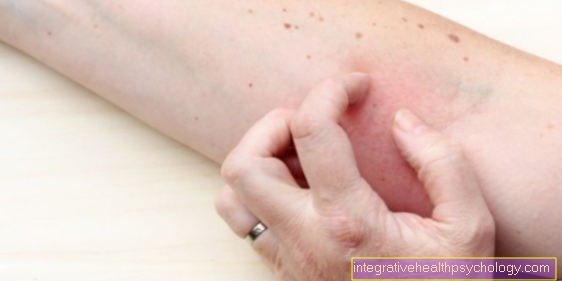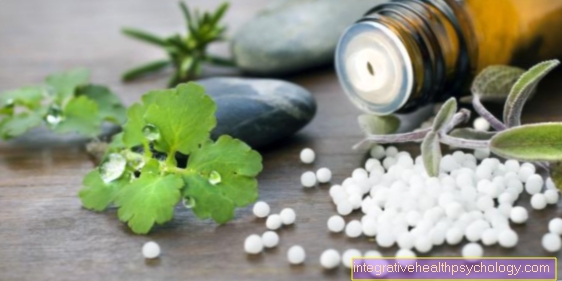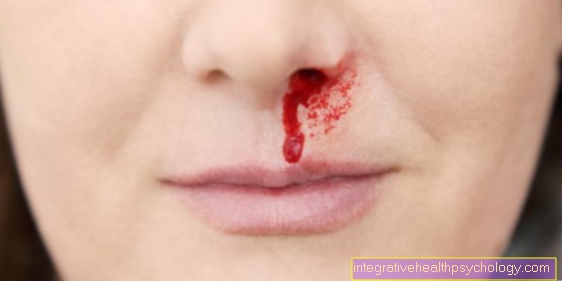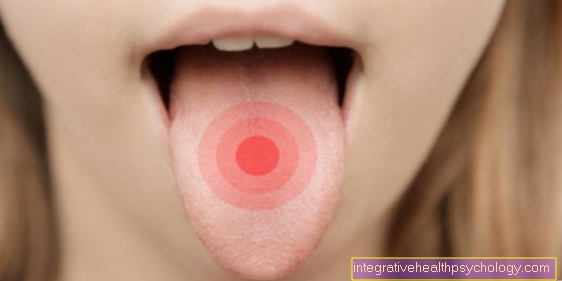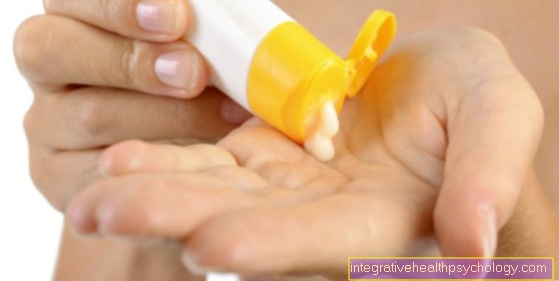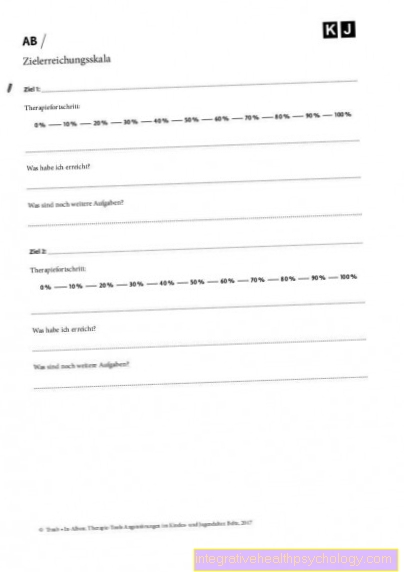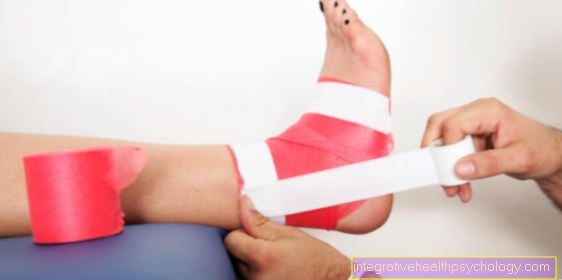Eye ointment for a stye
introduction
The stye (medicinally as Hordeolum is quite common. Typically, a stye appears on the edge of the eyelid as a small pus pimple. To relieve the uncomfortable swelling and pain, there are medications that can be applied to the eye as ointments or drops.

Which eye ointments can be used for stye?
Eye ointments that work against a stye usually contain an antibiotic that kills the bacteria that cause the inflammation. The active ingredients gentamycin or erythromycin are often used. These antibiotic eye ointments are only available from a pharmacy and must be prescribed by a doctor.
But there are also non-prescription eye ointments that are not specifically directed against stye, but can be used for general inflammation of the eye. This includes e.g. Bepanthen® eye and nasal ointment and the eye ointment Posiformin®.
Find out more at: Treat stye
Floxal® eye ointment
Floxal® 3 mg / g eye ointment contains the active ingredient ofloxacin, which is an antibiotic. It must be prescribed by the doctor.
Typically, Floxal® is used for inflammation of the eye, such as chronic connective tissue or corneal inflammation and corneal ulcer. Floxal® also helps with chlamydial infections of the eye.
Unless otherwise prescribed, a 1cm long strand of ointment is applied to the eye 3 to 5 times a day. Floxal® is not suitable for children under one year of age and for pregnant and breastfeeding women.
Read also below: Floxal eye ointment
Bepanthen® eye and nose ointment
Bepanthen® eye and nasal ointment is only available from a pharmacy but does not require a prescription. It can be used to support the treatment of damage or irritation of the cornea or conjunctiva as well as the nasal mucosa.
The active ingredient dexpanthenol (5%) promotes wound healing in damaged nasal mucosa or on the epithelium of the conjunctiva and cornea.
It is important that the tube once used in the nose should no longer be used on the eye in order to avoid contamination. In addition, the Bepanthen® eye and nasal ointment cannot relieve inflammation, so its use is more suitable for the post-treatment of stye.
Learn more about this at. Bepanthen® eye and nose ointment
How do eye ointments work on stye?
When an ophthalmologist prescribes an antibiotic eye ointment for a stye, the active ingredient is usually Erythromycin, Gentamicin or Ofloxacin. The latter have a bactericidal effect, while erythromycin has a bacteriostatic effect. Bactericidal means that the bacterium is killed directly, while bacteriostatic drugs prevent the bacteria from multiplying.
By reducing the number of bacteria, the inflammation can heal.
You might also be interested in: Eye drops containing antibiotics
The non-prescription eye ointments can then be used to aid healing. Their active ingredients serve to disinfect and regenerate the damaged mucous membrane or conjunctiva.
Using an eye ointment against a stye should show a clear improvement of the symptoms within 1 week at the latest. If this is not the case, the ophthalmologist should be visited again.
Side effects of eye ointments for a stye
With the antibiotic eye ointments Floxal® eye ointment, Gentamicin-POS® eye ointment and Ecolicin® eye ointment, i.a. the following side effects occur:
-
Irritation of the eye (redness, burning sensation, blurred vision, sensation of a foreign body)
-
Deposits on the cornea
-
Skin rashes with or blistering
-
Hypersensitivity reactions (asthma, itching, hives)
-
nausea
-
Disorders of smell and taste
The following side effects are known for the Bepanthen® eye and nasal ointment
-
allergic reaction
-
Skin reactions (redness, rash, eczema)
-
itching
These side effects are possible when using Posiformin® 2% eye ointment
-
Hypersensitivity (allergy) to Bibrocathol
-
Eye irritation (itchy eyes, swelling, pain, increased blood flow to the eye)
-
Facial swelling
-
Facial flushing
Interactions of eye ointments on stye
Since the eye ointments are only applied externally and not swallowed or injected, the interactions are limited.
However, one should note that after applying the eye ointment, one should wait at least 20-30 minutes before using contact lenses or other eye medication.
There are still no known interactions between Posiformin® 2% eye ointment or Bepanthen® eye and nasal ointment and other drugs.
No other drugs containing zinc, lead or mercury should be used while using Floxal® eye ointment.
Eye ointments containing erythromycin should not be combined with the active ingredients lincomycin, clindamycin or chloramphenicol in order not to weaken the effect.
Contraindications - When should eye ointments not be used on stye?
In the event of hypersensitivity or allergy to the active substance or other components of the eye ointment, the eye ointment must not be used.
Ecolicin® eye ointment and Bepanthen® eye and nasal ointment may also be used during pregnancy and breastfeeding.
If you have any questions about an eye ointment, you should refer to the package insert or contact your doctor or pharmacist.
Eye ointment during pregnancy and breastfeeding
Depending on the active ingredient, the eye ointment can also be used during pregnancy or while breastfeeding.
There are no indications of harmful effects for pregnant or breastfeeding mothers of the Bepanthen® eye and nasal ointment.
Before using an eye ointment (and any other medication), however, you should read the package leaflet carefully and ask the doctor or pharmacist treating you if you have any questions and, if necessary, point out the pregnancy or breastfeeding period.
This can also be of interest to you:
- Medication during breastfeeding
- Medication during pregnancy
Use of eye ointments on stye
Unless otherwise prescribed by the doctor, eye ointments are applied to the eye 1-5 times a day. As a rule, a 1 cm strand of ointment counts as one dose.
To avoid contamination of the ointment tube, the opening should never be touched directly or come into contact with the eye. One possibility of application is to put the ointment on a cosmetic tissue with washed hands and then to apply it to the eye with a clean cotton swab.
Further information can be found in the package insert.
Dosage of eye ointments against a stye
Eye ointments are used for external use on the eye.
A strand of ointment 0.5-1 cm long counts as one dose. The diameter of the extruded ointment rod should correspond to that of the tube opening.
What is available without a prescription?
In addition to the Bepanthen® eye and nasal ointment, the Posiformin® eye ointment with the active ingredient bibrocathol is available in pharmacies without a prescription. It does not have an antibiotic effect, only disinfectant.
The ointment should be applied to the affected areas of the eye with a clean cotton swab 3 to 5 times a day. If the symptoms do not improve or worsen, the (eye) doctor should be consulted.
How expensive is an eye ointment for a stye?
5g of Posiformin® eye ointment cost just under € 9. While 5g of Bepanthen® eye and nasal ointment cost less than € 2.
The eye ointments containing antibiotics are usually prescribed on a prescription so that they are free of charge for those with statutory health insurance.
Recommendations from the editorial team
You might also be interested in these topics:
- Stye
- Treat stye
- Floxal eye ointment
- Eye drops containing antibiotics
- Stye and contact lenses
Exclusion of liability / disclaimer
We would like to point out that medication must never be discontinued, applied or changed independently without consulting your doctor.
Please note that we cannot claim that our texts are complete or correct. The information may be out of date due to current developments.



